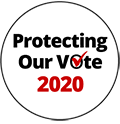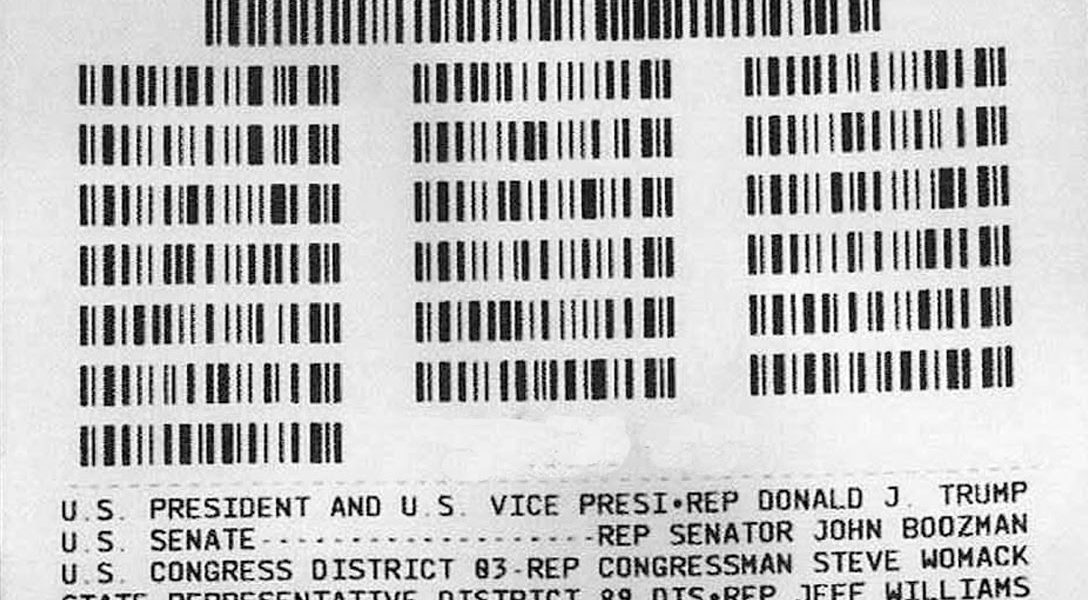While more states move toward hand-marked paper ballots, others will keep using outdated voting machines that are hackable and known to have serious security flaws.

Election officials know very well that using outdated and costly touchscreen voting machines — which are susceptible to hacking and other foul play — will likely lead to programming issues and cause long lines during the 2020 election that will ultimately drive voters away from the polls.
Though more states are moving toward hand-marked paper ballots, most of those ballots will still be counted by machines. In other states — some of which could play a crucial role this year — election officials have ignored calls by election security experts to steer clear of problematic touchscreen machines altogether, and are rushing to approve even more.
In North Carolina, despite overwhelming opposition from voters and election security experts, the State Board of Elections (NCSBE) bypassed a certification process to approve new touchscreen voting machines by Election Systems & Software (ES&S). At the same time, it expressed “disappointment” in the company for misleading the board about whether it could provide enough of the voting machines that were certified in August.
Critics of the decision argue that election officials rushed to approve the modification request after the board was forced to consider a more expensive voting machine just one month after the initial certification in August because ES&S said that it could not supply North Carolina with all the machines the state needed.
How Did We Get Here?
NCSBE approved the new voting machines in a 3–2 vote. Stella Anderson, a Democrat on the board who voted against it, called the measure a false choice because counties could switch to hand-marked paper ballots.
Still, 20 of North Carolina’s 100 counties announced they will stick with the outdated direct-recording electronic (DRE) voting machines that the board voted to replace.
ES&S is one of only a handful of companies that provide voting machines and other election equipment throughout the country. Clear Ballot — which the board certified along with ES&S’s machines in August — also submitted a modification request to be considered during the board’s final meeting of the year. But the company withdrew its request and cited the certification process, or lack thereof, as the reason. Clear Ballot also called for an investigation into whether ES&S improperly acted to dominate the state with its voting machines, calling it a “virtual monopoly.”
Similar concerns were raised last year in Georgia about a rush to upgrade decades-old voting machines without following the legal requirements. Election integrity advocates and thousands of voters demanded a recertification process for the state’s purchase of ballot-marking devices (BMDs), saying that state officials didn’t even disclose who oversaw the certification.
The DREs used in North Carolina and dozens of other states are prone to numerous programming issues that, among other things, can lead to misprinted ballots. Although voters can correct their choice on the touchscreen voting machine, the actual ballot that is counted is printed as a barcode — which election officials cannot verify.
The new BMD voting machines function like DREs and have been proven to be hackable. In an ideal setting, voters select their choice on a touchscreen device and their ballot is counted electronically.
“We’re at this place where we’ll have to consider the ExpressVote 2.1 because the vendor came along in the 11th hour, after we had certified the [first] system and said, ‘Oh by the way, we don’t have those units anymore,’” Anderson said before the board approved the new machines.
Election security experts say that NCSBE failed to comply with state law that requires any new equipment to undergo a certification process, placing voters in a position where they won’t know whether their votes will be accurately counted.
The approved modifications, experts say, constituted entirely new models, and should have undergone a certification process to ensure the machines complied with state law.
State Rep. Verla Insko (D) echoed Anderson’s concerns in a letter to the board, obtained by WhoWhaWhy. Although Insko did not call for the board to decertify the machines, she urged them to “delay the use of this machine until after the 2020 election, until you and other board members have ample time to do a full new certification of this new machine — as is required by the 2005 Confidence in Election law.”
Patrick Gannon, spokesperson for NCSBE, denied any improprieties to WhoWhatWhy and said that the board determined that the changes were minor and therefore did not require a full certification process.
“There are no operational differences between the two versions,” Gannon contended, adding that the approval was routine for updates to elections systems.
Falsehoods and Outrage
Susan Greenhalgh, vice president of policy and programs for the National Election Defense Coalition, wrote to the board before the vote and warned that they were “disregarding principle requirements in North Carolina law” by not undergoing a certification process on the new touchscreen voting machines, or holding a meeting open to the public.
“In order to rightly earn public trust, election administrators must vigorously review new voting systems and strictly enforce testing and certification requirements,” Greenhalgh wrote. “Even the appearance of improper certification must be avoided at all costs.”
The touchscreen voting machines approved in North Carolina were developed after the 2002 passage of the Help America Vote Act, in order to assist voters with disabilities.
To avoid further instances of the infamous “hanging chads” during the 2000 presidential election, election equipment manufacturers have been pushing for these costly machines to be used by all voters, Dr. Rebecca Mercuri, a computer scientist and founder of the election security firm Notable Software, told WhoWhatWhy.
Mercuri noted that the Voluntary Voting System Guidelines, passed in 2005 by the federal government, are just that — voluntary and guidelines — so voting machine vendors are not required by law to abide by them. Most states have passed the guidelines into law, but it’s like examining airplanes, or at least it should be, Mercuri said.
Prior to her work in elections, Mercuri worked in aviation and certified that things like the software and dials that went into planes met federal requirements. Many of the standards are extremely specific — but voting machines are not treated nearly the same, Mercuri explained.
“We know how to create specifications for electronic equipment that’s readable and accessible … and we don’t do that for voting machines,” Mercuri said.
New Machines, Same Problems
Some election experts have called for an independent investigation into whether anyone was bribed, considering that ES&S has been known to mingle with the Republican Party.
The approval was really the result of a bait-and-switch by ES&S, John R. Brakey, director of election watchdog group AUDIT USA, told WhoWhatWhy.
“The first machine that they sold was a BMD. There are no operational differences until you decide, ‘Guess what? There’s fleeing voters. People are taking those tickets out with them. They think they’re receipts — we’ve got to stop this!’” Brakey said.
Georgians Demand Secretary of State Re-Examine Voting System
“[The ES&S machine] takes away voter intent because voter intent is them making a mark, not a machine doing it,” Brakey said. “Forensically, it’s a lot harder to forge a hand-marked paper ballot than it is to have these thermal paper ballots.”
Recent studies show that when voters are asked to make a selection on a touchscreen, they often do not review their ballot before putting it through an optical scanning machine, Harri Hursti, cybersecurity expert and co-founder of DEFCON Voting Machine Hacking Village, told WhoWhatWhy.
Even worse, Hursti explained, “some of the voting machines, which we in the cybersecurity community lovingly call ‘license to cheat’ machines, have a feature where the voter is asked to tell whether they want to see the ballot before the ballot itself is printed.”
If a voter opts to not review it before confirming their selection, the machines produce what’s known as a summary ballot card — which is unreadable by humans. That barcode, rather than the human readable part of the ballot, is what BMDs actually tally.
“You can’t verify what that barcode says,” Hursti said.
Profit-Driven Motives
Brakey raised concerns about whether ES&S lobbyists misled the public on what’s known as “timing marks.” Optically scanned hand-marked paper ballots have these marks so a machine can read where a vote is on the ballot.
Older models of these machines would look for dark spots to identify where the voter marks their ballot. Newer models snap a picture of the entire ballot instead of scanning for pen marks — and that process can lead to misread ballots.
“It was sickening to watch these corporate hucksters and their lobbyists mislead really good people like it was a game,” Brakey said.
It all comes down to profits, Mercuri explained. Election officials can’t afford the millions of dollars needed to certify voting machines, so they rely on proof provided by companies like ES&S. The certification process is a shell game, Mercuri argued, that has gone on for more than two decades.
The handful of companies that dominate the election equipment market are also closely held family businesses, so the information is heavily guarded from officials. In other words, it’s a legacy business.
It’s no secret that voting machine companies are held to a lower standard than other critical industries, like aviation, Mercuri said, adding that “it’s not something that happened overnight … it’s something that’s been going on for a century.”
County election officials want to move away from paper, but doing so is still impossible due to things like vote-by-mail, Brakey said. And, election security experts argue that aside from addressing cybersecurity concerns, placing a dozen tables at a polling place for voters to hand-mark a ballot is far more cost efficient than the machines NCSBE approved. It’s like a charade, Mercuri said.
Guilford County, which has one of the largest voting-age populations in the state, budgeted $8 million for new voting machines earlier this year, but experts say that the state would need to spend only a fraction of that if officials decided to implement hand-marked paper ballots.
BMDs Lack Serious Safety Protocols
The decision to approve BMDs in North Carolina came as election officials throughout the country scramble to provide voters with paper-based voting machines in order to ease the concerns about whether their votes will count in 2020.
Congress passed a spending package that includes $425 million for states to beef up their election security, but it did not mandate how the money should be used — leaving many unsure whether states will use the funds to purchase more vulnerable voting equipment instead of hand-marked paper ballots.
Brakey sent an open letter to NCSBE and warned of the havoc that these new voting machines could wreak. Brakey urged the board to scrap its deal with ES&S, and implement a more cost-effective system: hand-marked paper ballots.
“ES&S found many ways to disparage hand-marked paper ballots, including telling county Boards of Elections that voters don’t fill in the bubbles correctly, and the ExpressVote will fix that,” Brakey wrote.
“This falsehood ignores the fact that most voters do fill in the bubbles correctly, and hand-marked paper ballots is the only voting method where voter intent can be accurately determined.”
BMDs have continued to raise concerns after hackers at this year’s Voting Village, the largest annual hackers conference, tested two variations of BMDs for the first time. Some experts, like then-deputy commissioner of Virginia elections Liz Howard — who testified with Hursti at a recent House Homeland Security Committee hearing — took into consideration the Village’s discoveries during its first conference in 2017, and implemented hand-marked paper ballots in time for the local elections that year.
The conference takes place in August every year, so Howard — who now works for the Brennan Center for Justice as counsel on election security — had just a few weeks to prepare Virginia at the time. The state’s board of elections unanimously decertified all paperless voting machines and cited the Voting Village’s findings as the reason to act quickly. Few issues were reported after the switch to paper ballots.
Although it was not the first time the Village tested these touchscreen voting machines, last year’s conference showed that both units — each manufactured by different vendors — could be hacked in fewer than eight hours, and lacked serious security protocols.
The vendors defended their equipment and argued that voters could simply inspect their printed ballots before printing and putting them through a machine that counts the ballots.
But, Hursti contended, “it is not the voters’ job to verify that the machines worked correctly.”
Switching to hand-marked paper ballots would significantly lower costs for taxpayers and better comply with the 2002 HAVA law. Adding a dozen tables for voters to fill in a paper ballot would cost just a fraction of the cost to have and upkeep a handful of BMDs.
During a public demonstration of BMDs in Florida, Mercuri said, she also saw many older voters struggle to use these machines without assistance, adding that the machines are not as accessible as voting machine vendors say.
It’s just one example after another as to why these machines should be scrapped even for voters with disabilities, Mercuri explained. In 2004, for example, a set of voting machines in California instructed blind voters to cast their vote on a BMD by selecting the yellow button, something that a blind voter would find impossible to do.
Related front page panorama photo credit: Adapted by WhoWhatWhy from Verified Voting Foundation, Inc, and BlueRidgeKitties / Flickr (CC BY-NC-SA 2.0).



